Analysis and Visualization of Shift in Energy Supply and Demand
VerifiedAdded on 2021/04/21
|6
|1545
|42
Report
AI Summary
This report examines the global shift in energy supply and demand, focusing on the role of fossil fuels and their implications for climate change and energy security. It uses cartograms to visualize the spatial distribution of energy consumers and producers, highlighting the increasing demand from developing economies. The study analyzes data from various sources, including BP, EIA, and IEA, to illustrate trends in oil, coal, and gas production and consumption. The report reviews existing literature on the drivers of energy demand, such as industrialization, population growth, and economic development, and discusses the impact of these trends on global energy trade and financial flows. The methodology involves the use of cartograms, a visualization technique that rescales regions based on attribute values, to provide an intuitive representation of the energy landscape. The report concludes by emphasizing the importance of understanding these shifts for addressing climate change and ensuring sustainable energy supplies.
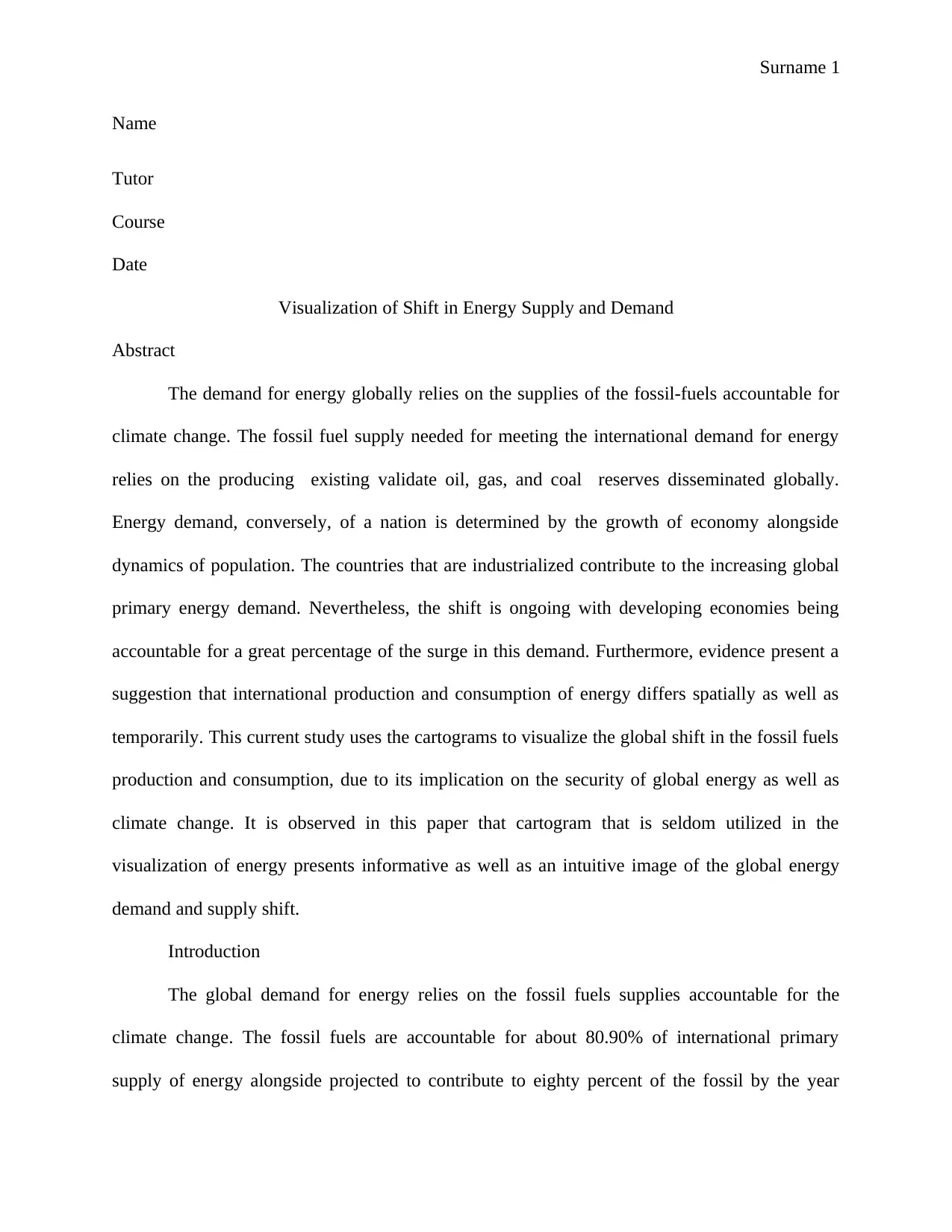
Surname 1
Name
Tutor
Course
Date
Visualization of Shift in Energy Supply and Demand
Abstract
The demand for energy globally relies on the supplies of the fossil-fuels accountable for
climate change. The fossil fuel supply needed for meeting the international demand for energy
relies on the producing existing validate oil, gas, and coal reserves disseminated globally.
Energy demand, conversely, of a nation is determined by the growth of economy alongside
dynamics of population. The countries that are industrialized contribute to the increasing global
primary energy demand. Nevertheless, the shift is ongoing with developing economies being
accountable for a great percentage of the surge in this demand. Furthermore, evidence present a
suggestion that international production and consumption of energy differs spatially as well as
temporarily. This current study uses the cartograms to visualize the global shift in the fossil fuels
production and consumption, due to its implication on the security of global energy as well as
climate change. It is observed in this paper that cartogram that is seldom utilized in the
visualization of energy presents informative as well as an intuitive image of the global energy
demand and supply shift.
Introduction
The global demand for energy relies on the fossil fuels supplies accountable for the
climate change. The fossil fuels are accountable for about 80.90% of international primary
supply of energy alongside projected to contribute to eighty percent of the fossil by the year
Name
Tutor
Course
Date
Visualization of Shift in Energy Supply and Demand
Abstract
The demand for energy globally relies on the supplies of the fossil-fuels accountable for
climate change. The fossil fuel supply needed for meeting the international demand for energy
relies on the producing existing validate oil, gas, and coal reserves disseminated globally.
Energy demand, conversely, of a nation is determined by the growth of economy alongside
dynamics of population. The countries that are industrialized contribute to the increasing global
primary energy demand. Nevertheless, the shift is ongoing with developing economies being
accountable for a great percentage of the surge in this demand. Furthermore, evidence present a
suggestion that international production and consumption of energy differs spatially as well as
temporarily. This current study uses the cartograms to visualize the global shift in the fossil fuels
production and consumption, due to its implication on the security of global energy as well as
climate change. It is observed in this paper that cartogram that is seldom utilized in the
visualization of energy presents informative as well as an intuitive image of the global energy
demand and supply shift.
Introduction
The global demand for energy relies on the fossil fuels supplies accountable for the
climate change. The fossil fuels are accountable for about 80.90% of international primary
supply of energy alongside projected to contribute to eighty percent of the fossil by the year
Paraphrase This Document
Need a fresh take? Get an instant paraphrase of this document with our AI Paraphraser
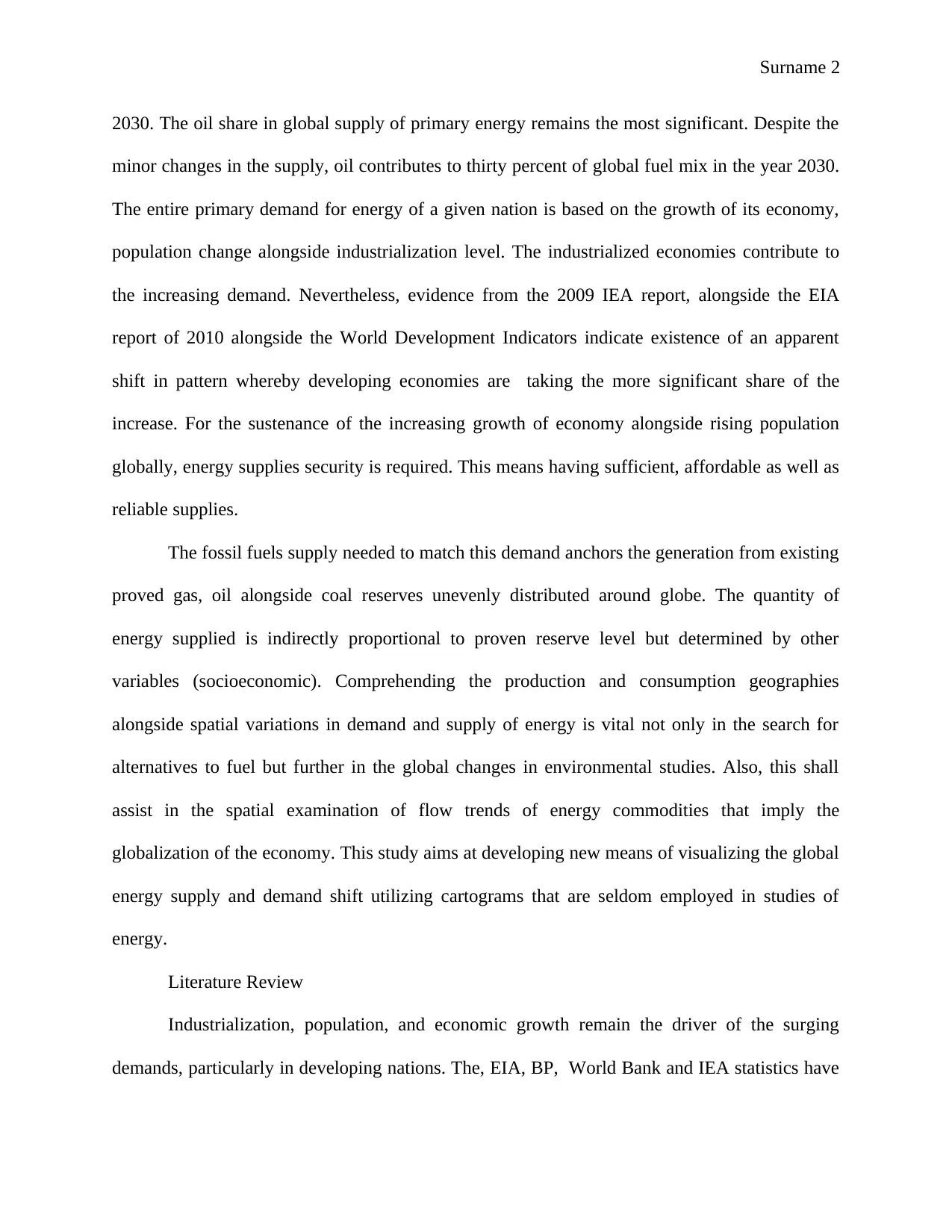
Surname 2
2030. The oil share in global supply of primary energy remains the most significant. Despite the
minor changes in the supply, oil contributes to thirty percent of global fuel mix in the year 2030.
The entire primary demand for energy of a given nation is based on the growth of its economy,
population change alongside industrialization level. The industrialized economies contribute to
the increasing demand. Nevertheless, evidence from the 2009 IEA report, alongside the EIA
report of 2010 alongside the World Development Indicators indicate existence of an apparent
shift in pattern whereby developing economies are taking the more significant share of the
increase. For the sustenance of the increasing growth of economy alongside rising population
globally, energy supplies security is required. This means having sufficient, affordable as well as
reliable supplies.
The fossil fuels supply needed to match this demand anchors the generation from existing
proved gas, oil alongside coal reserves unevenly distributed around globe. The quantity of
energy supplied is indirectly proportional to proven reserve level but determined by other
variables (socioeconomic). Comprehending the production and consumption geographies
alongside spatial variations in demand and supply of energy is vital not only in the search for
alternatives to fuel but further in the global changes in environmental studies. Also, this shall
assist in the spatial examination of flow trends of energy commodities that imply the
globalization of the economy. This study aims at developing new means of visualizing the global
energy supply and demand shift utilizing cartograms that are seldom employed in studies of
energy.
Literature Review
Industrialization, population, and economic growth remain the driver of the surging
demands, particularly in developing nations. The, EIA, BP, World Bank and IEA statistics have
2030. The oil share in global supply of primary energy remains the most significant. Despite the
minor changes in the supply, oil contributes to thirty percent of global fuel mix in the year 2030.
The entire primary demand for energy of a given nation is based on the growth of its economy,
population change alongside industrialization level. The industrialized economies contribute to
the increasing demand. Nevertheless, evidence from the 2009 IEA report, alongside the EIA
report of 2010 alongside the World Development Indicators indicate existence of an apparent
shift in pattern whereby developing economies are taking the more significant share of the
increase. For the sustenance of the increasing growth of economy alongside rising population
globally, energy supplies security is required. This means having sufficient, affordable as well as
reliable supplies.
The fossil fuels supply needed to match this demand anchors the generation from existing
proved gas, oil alongside coal reserves unevenly distributed around globe. The quantity of
energy supplied is indirectly proportional to proven reserve level but determined by other
variables (socioeconomic). Comprehending the production and consumption geographies
alongside spatial variations in demand and supply of energy is vital not only in the search for
alternatives to fuel but further in the global changes in environmental studies. Also, this shall
assist in the spatial examination of flow trends of energy commodities that imply the
globalization of the economy. This study aims at developing new means of visualizing the global
energy supply and demand shift utilizing cartograms that are seldom employed in studies of
energy.
Literature Review
Industrialization, population, and economic growth remain the driver of the surging
demands, particularly in developing nations. The, EIA, BP, World Bank and IEA statistics have
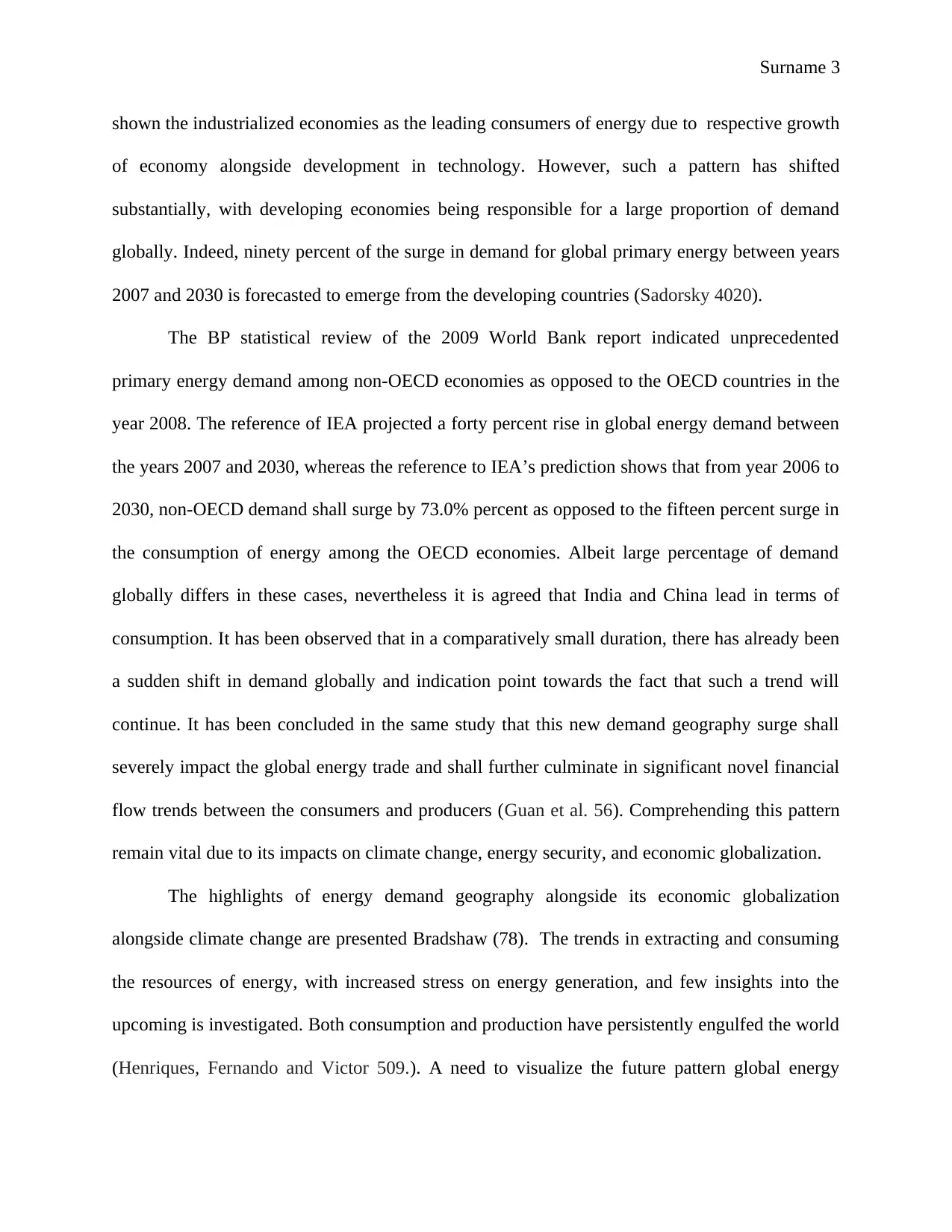
Surname 3
shown the industrialized economies as the leading consumers of energy due to respective growth
of economy alongside development in technology. However, such a pattern has shifted
substantially, with developing economies being responsible for a large proportion of demand
globally. Indeed, ninety percent of the surge in demand for global primary energy between years
2007 and 2030 is forecasted to emerge from the developing countries (Sadorsky 4020).
The BP statistical review of the 2009 World Bank report indicated unprecedented
primary energy demand among non-OECD economies as opposed to the OECD countries in the
year 2008. The reference of IEA projected a forty percent rise in global energy demand between
the years 2007 and 2030, whereas the reference to IEA’s prediction shows that from year 2006 to
2030, non-OECD demand shall surge by 73.0% percent as opposed to the fifteen percent surge in
the consumption of energy among the OECD economies. Albeit large percentage of demand
globally differs in these cases, nevertheless it is agreed that India and China lead in terms of
consumption. It has been observed that in a comparatively small duration, there has already been
a sudden shift in demand globally and indication point towards the fact that such a trend will
continue. It has been concluded in the same study that this new demand geography surge shall
severely impact the global energy trade and shall further culminate in significant novel financial
flow trends between the consumers and producers (Guan et al. 56). Comprehending this pattern
remain vital due to its impacts on climate change, energy security, and economic globalization.
The highlights of energy demand geography alongside its economic globalization
alongside climate change are presented Bradshaw (78). The trends in extracting and consuming
the resources of energy, with increased stress on energy generation, and few insights into the
upcoming is investigated. Both consumption and production have persistently engulfed the world
(Henriques, Fernando and Victor 509.). A need to visualize the future pattern global energy
shown the industrialized economies as the leading consumers of energy due to respective growth
of economy alongside development in technology. However, such a pattern has shifted
substantially, with developing economies being responsible for a large proportion of demand
globally. Indeed, ninety percent of the surge in demand for global primary energy between years
2007 and 2030 is forecasted to emerge from the developing countries (Sadorsky 4020).
The BP statistical review of the 2009 World Bank report indicated unprecedented
primary energy demand among non-OECD economies as opposed to the OECD countries in the
year 2008. The reference of IEA projected a forty percent rise in global energy demand between
the years 2007 and 2030, whereas the reference to IEA’s prediction shows that from year 2006 to
2030, non-OECD demand shall surge by 73.0% percent as opposed to the fifteen percent surge in
the consumption of energy among the OECD economies. Albeit large percentage of demand
globally differs in these cases, nevertheless it is agreed that India and China lead in terms of
consumption. It has been observed that in a comparatively small duration, there has already been
a sudden shift in demand globally and indication point towards the fact that such a trend will
continue. It has been concluded in the same study that this new demand geography surge shall
severely impact the global energy trade and shall further culminate in significant novel financial
flow trends between the consumers and producers (Guan et al. 56). Comprehending this pattern
remain vital due to its impacts on climate change, energy security, and economic globalization.
The highlights of energy demand geography alongside its economic globalization
alongside climate change are presented Bradshaw (78). The trends in extracting and consuming
the resources of energy, with increased stress on energy generation, and few insights into the
upcoming is investigated. Both consumption and production have persistently engulfed the world
(Henriques, Fernando and Victor 509.). A need to visualize the future pattern global energy
⊘ This is a preview!⊘
Do you want full access?
Subscribe today to unlock all pages.

Trusted by 1+ million students worldwide
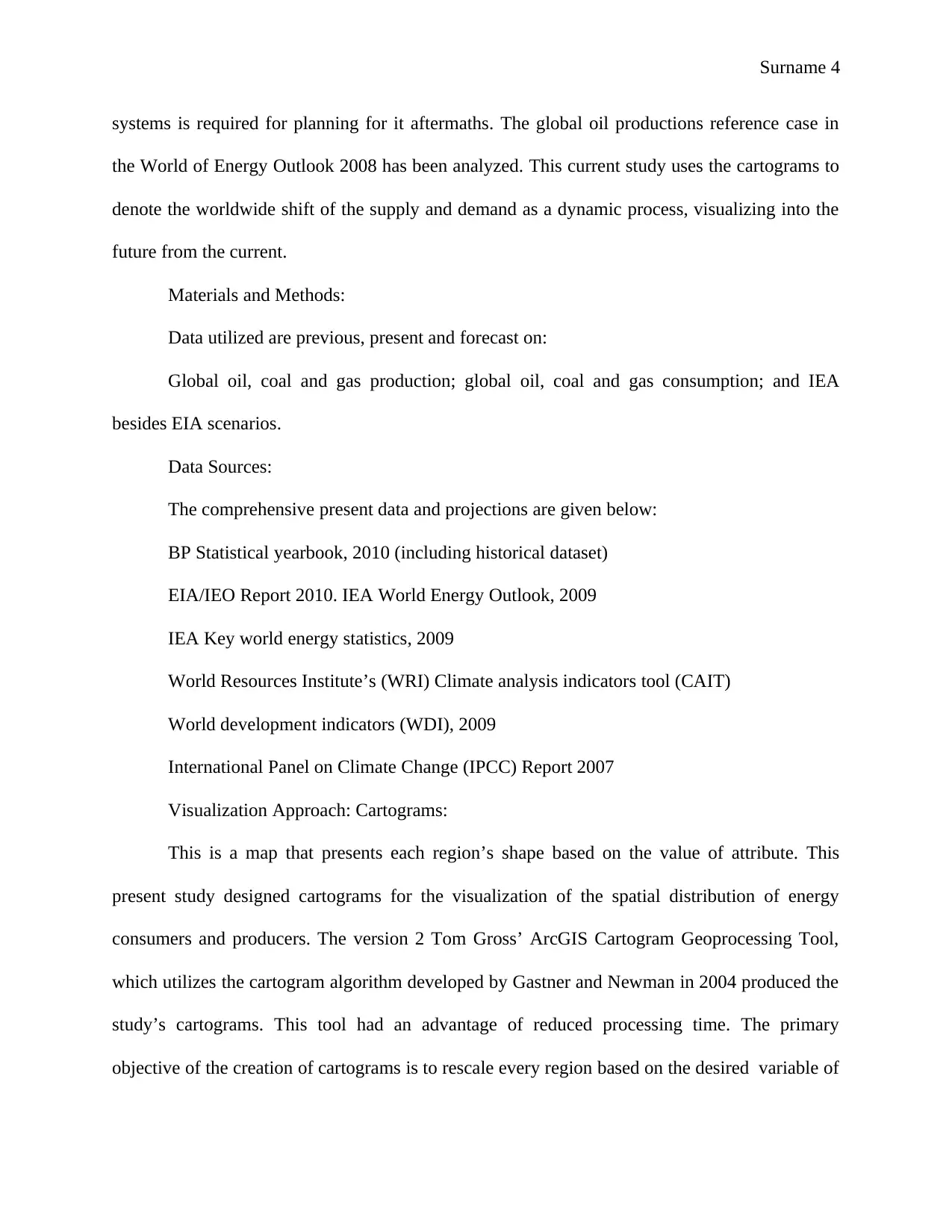
Surname 4
systems is required for planning for it aftermaths. The global oil productions reference case in
the World of Energy Outlook 2008 has been analyzed. This current study uses the cartograms to
denote the worldwide shift of the supply and demand as a dynamic process, visualizing into the
future from the current.
Materials and Methods:
Data utilized are previous, present and forecast on:
Global oil, coal and gas production; global oil, coal and gas consumption; and IEA
besides EIA scenarios.
Data Sources:
The comprehensive present data and projections are given below:
BP Statistical yearbook, 2010 (including historical dataset)
EIA/IEO Report 2010. IEA World Energy Outlook, 2009
IEA Key world energy statistics, 2009
World Resources Institute’s (WRI) Climate analysis indicators tool (CAIT)
World development indicators (WDI), 2009
International Panel on Climate Change (IPCC) Report 2007
Visualization Approach: Cartograms:
This is a map that presents each region’s shape based on the value of attribute. This
present study designed cartograms for the visualization of the spatial distribution of energy
consumers and producers. The version 2 Tom Gross’ ArcGIS Cartogram Geoprocessing Tool,
which utilizes the cartogram algorithm developed by Gastner and Newman in 2004 produced the
study’s cartograms. This tool had an advantage of reduced processing time. The primary
objective of the creation of cartograms is to rescale every region based on the desired variable of
systems is required for planning for it aftermaths. The global oil productions reference case in
the World of Energy Outlook 2008 has been analyzed. This current study uses the cartograms to
denote the worldwide shift of the supply and demand as a dynamic process, visualizing into the
future from the current.
Materials and Methods:
Data utilized are previous, present and forecast on:
Global oil, coal and gas production; global oil, coal and gas consumption; and IEA
besides EIA scenarios.
Data Sources:
The comprehensive present data and projections are given below:
BP Statistical yearbook, 2010 (including historical dataset)
EIA/IEO Report 2010. IEA World Energy Outlook, 2009
IEA Key world energy statistics, 2009
World Resources Institute’s (WRI) Climate analysis indicators tool (CAIT)
World development indicators (WDI), 2009
International Panel on Climate Change (IPCC) Report 2007
Visualization Approach: Cartograms:
This is a map that presents each region’s shape based on the value of attribute. This
present study designed cartograms for the visualization of the spatial distribution of energy
consumers and producers. The version 2 Tom Gross’ ArcGIS Cartogram Geoprocessing Tool,
which utilizes the cartogram algorithm developed by Gastner and Newman in 2004 produced the
study’s cartograms. This tool had an advantage of reduced processing time. The primary
objective of the creation of cartograms is to rescale every region based on the desired variable of
Paraphrase This Document
Need a fresh take? Get an instant paraphrase of this document with our AI Paraphraser
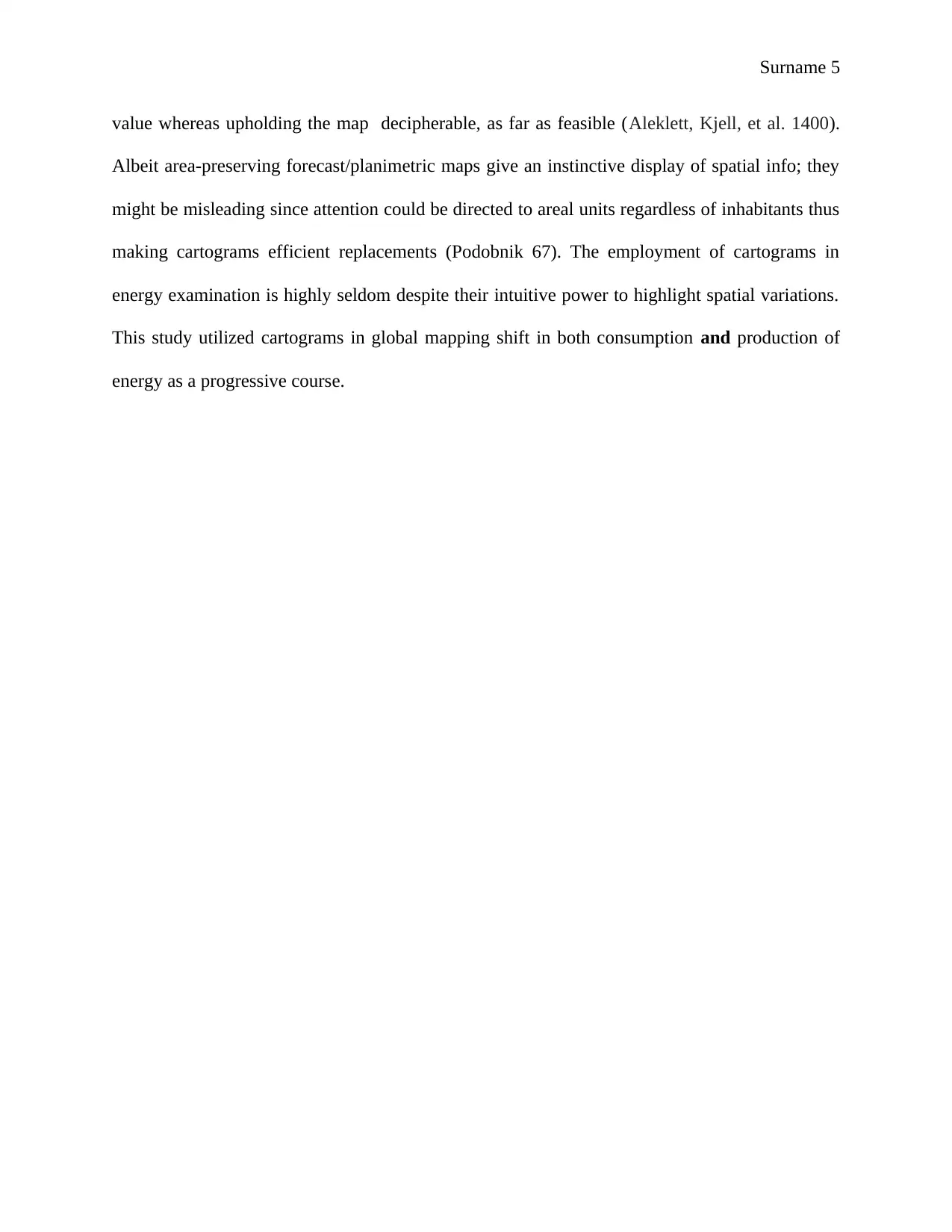
Surname 5
value whereas upholding the map decipherable, as far as feasible (Aleklett, Kjell, et al. 1400).
Albeit area-preserving forecast/planimetric maps give an instinctive display of spatial info; they
might be misleading since attention could be directed to areal units regardless of inhabitants thus
making cartograms efficient replacements (Podobnik 67). The employment of cartograms in
energy examination is highly seldom despite their intuitive power to highlight spatial variations.
This study utilized cartograms in global mapping shift in both consumption and production of
energy as a progressive course.
value whereas upholding the map decipherable, as far as feasible (Aleklett, Kjell, et al. 1400).
Albeit area-preserving forecast/planimetric maps give an instinctive display of spatial info; they
might be misleading since attention could be directed to areal units regardless of inhabitants thus
making cartograms efficient replacements (Podobnik 67). The employment of cartograms in
energy examination is highly seldom despite their intuitive power to highlight spatial variations.
This study utilized cartograms in global mapping shift in both consumption and production of
energy as a progressive course.
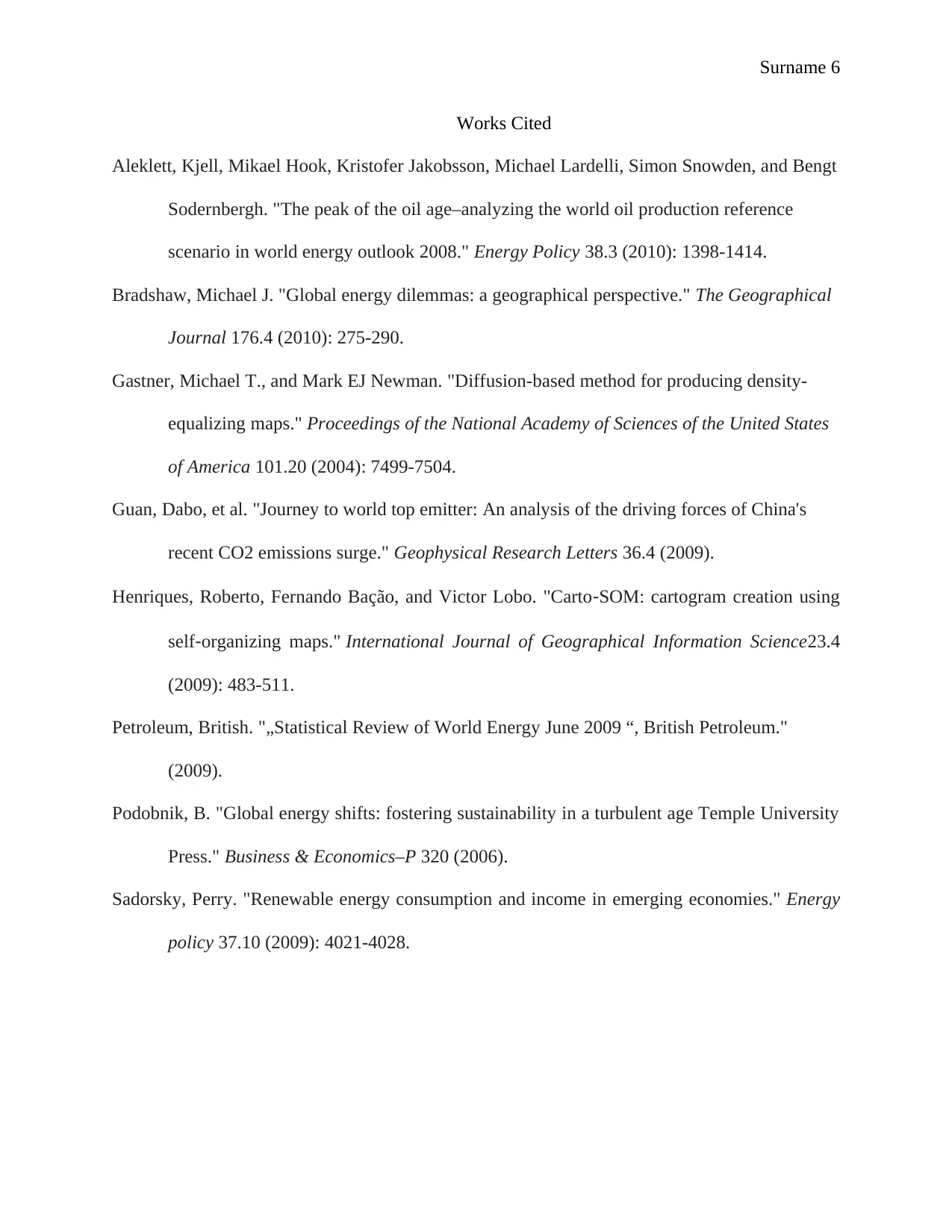
Surname 6
Works Cited
Aleklett, Kjell, Mikael Hook, Kristofer Jakobsson, Michael Lardelli, Simon Snowden, and Bengt
Sodernbergh. "The peak of the oil age–analyzing the world oil production reference
scenario in world energy outlook 2008." Energy Policy 38.3 (2010): 1398-1414.
Bradshaw, Michael J. "Global energy dilemmas: a geographical perspective." The Geographical
Journal 176.4 (2010): 275-290.
Gastner, Michael T., and Mark EJ Newman. "Diffusion-based method for producing density-
equalizing maps." Proceedings of the National Academy of Sciences of the United States
of America 101.20 (2004): 7499-7504.
Guan, Dabo, et al. "Journey to world top emitter: An analysis of the driving forces of China's
recent CO2 emissions surge." Geophysical Research Letters 36.4 (2009).
Henriques, Roberto, Fernando Bação, and Victor Lobo. "Carto‐SOM: cartogram creation using
self‐organizing maps." International Journal of Geographical Information Science23.4
(2009): 483-511.
Petroleum, British. "„Statistical Review of World Energy June 2009 “, British Petroleum."
(2009).
Podobnik, B. "Global energy shifts: fostering sustainability in a turbulent age Temple University
Press." Business & Economics–P 320 (2006).
Sadorsky, Perry. "Renewable energy consumption and income in emerging economies." Energy
policy 37.10 (2009): 4021-4028.
Works Cited
Aleklett, Kjell, Mikael Hook, Kristofer Jakobsson, Michael Lardelli, Simon Snowden, and Bengt
Sodernbergh. "The peak of the oil age–analyzing the world oil production reference
scenario in world energy outlook 2008." Energy Policy 38.3 (2010): 1398-1414.
Bradshaw, Michael J. "Global energy dilemmas: a geographical perspective." The Geographical
Journal 176.4 (2010): 275-290.
Gastner, Michael T., and Mark EJ Newman. "Diffusion-based method for producing density-
equalizing maps." Proceedings of the National Academy of Sciences of the United States
of America 101.20 (2004): 7499-7504.
Guan, Dabo, et al. "Journey to world top emitter: An analysis of the driving forces of China's
recent CO2 emissions surge." Geophysical Research Letters 36.4 (2009).
Henriques, Roberto, Fernando Bação, and Victor Lobo. "Carto‐SOM: cartogram creation using
self‐organizing maps." International Journal of Geographical Information Science23.4
(2009): 483-511.
Petroleum, British. "„Statistical Review of World Energy June 2009 “, British Petroleum."
(2009).
Podobnik, B. "Global energy shifts: fostering sustainability in a turbulent age Temple University
Press." Business & Economics–P 320 (2006).
Sadorsky, Perry. "Renewable energy consumption and income in emerging economies." Energy
policy 37.10 (2009): 4021-4028.
⊘ This is a preview!⊘
Do you want full access?
Subscribe today to unlock all pages.

Trusted by 1+ million students worldwide
1 out of 6
Related Documents
Your All-in-One AI-Powered Toolkit for Academic Success.
+13062052269
info@desklib.com
Available 24*7 on WhatsApp / Email
![[object Object]](/_next/static/media/star-bottom.7253800d.svg)
Unlock your academic potential
Copyright © 2020–2025 A2Z Services. All Rights Reserved. Developed and managed by ZUCOL.





